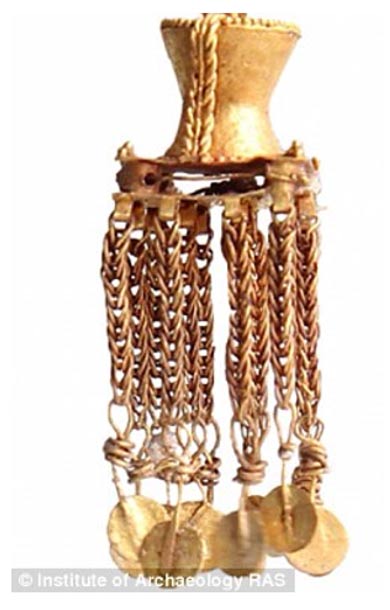
Priceless treasure hoard found in 1st century grave of Sarmatian woman in Russia
Archaeologists doing exploratory digging for an airport in Russia have found the grave of an apparent noblewoman with very valuable items, including a sword and knives, gold and silver jewelry, elaborately decorated clothing, a bronze mirror and a decorated bronze bucket. The 1 st century AD grave is of the Sarmatian people, whose women are believed to have inspired Greek accounts of the warrior-women Amazons.
The Daily Mail said archaeologists have labelled the treasure from the grave, which is near Rostov-on-Don, as priceless. The woman's remains were apparently buried with her husband, whose grave had been looted as had most of the other 28 burial mounds found at the airport site. By analyzing the woman's teeth, experts concluded she lived to old age and had survived battles.
In addition to the gold and silver jewelry, archaeologists found a gold flask, 100 iron arrowheads, a gem with an Aramaic of Phoenician inscription that was laid upon her chest, pottery and remnants of a bronze bucket that was decorated with a Gorgon's head and floral motifs. The grave also had a hiding place with some knives and an unfinished sword with brooches on its handle.

Gold and silver jewelry was found in the woman's grave, including these gold earrings (Russian Institute of Archaeology photo)
“It is interesting that there are two burials in this mound,” archaeologist Roman Mimokhod told the Mail the Russian Academy of Science's Institute of Archaeology. “One obviously belonged to a man and was totally looted. We found only some fragments of crockery and scattered bones. We will check the bones, but we are almost sure it was some noble man. The second burial belonged to the woman. We believe that it was a double burial of some noble Sarmatian and his wife.”
He said the discovery of the arrowheads is indirect confirmation of ancient historians' relating that Sarmatian women were involved in hostilities and battle. In addition, there was a harness, indicating she may have been a horse rider.
“The collar of her dress was decorated with stamped buckles of gold leaf in the form of a stylised ram's head,” he said. “Her sleeves were embroidered with colourful beads combined with gold triangular and hemispherical plaques.”
She had gold bracelets on both wrists, and on her chest were beads that included the gem with the inscription. The gold vial was at her pelvis. The vial had a tight lid and its contents were fossilized, which will be analyzed but may have been incense. She had by her right hand fragments of a cup and some wooden dishes, the Mail says.
The nomadic Sarmatian people were of Iranian heritage who moved from Central Asia to the Ural Mountains between the 6 th and 4 th centuries BC. The site UNRV History says Greeks and Romans speculated that the Sarmatians were Amazons because their women had much higher status in society than women in Mediterranean societies.

This gem, found on the woman's chest, has an inscription in either Aramaic or Phoenician. (Russian Institute of Archaeology photo)
Sarmatian territory stretched from the Caspian Sea to the Vistula River and south to the Danube. The people were independent tribes that at their height occupied parts of Russia, the Ukraine and the Baltic states, Romania, Poland and parts of Central Asia.
The Sarmatians demanded and got tribute from some Greek cities within their purview and eventually butted heads with the Roman Empire. Their history reads like a Game of Thrones synopsis as they allied alternately with Rome and tribes opposed to Rome. Eventually some settled down in Dacia. Others were overrun in the north by Huns and Goths. Some of them ended up in England, which is an interesting tale to tell.
“Their transfer to Britain has helped feed speculation on the origin of King Arthur,” says the UNRV site. “Lucius Artorius Castus, a Roman cavalry officer serving in the 2nd century AD has often been associated with one possible source of the true historical Arthur.” Artorius commanded a troop of Sarmatian cavalry. The site says the Sarmatians also helped fend off Saxon invasions after Rome withdrew, which may have contributed to the mythology of King Arthur. For a detailed study of the parallels between Arthur and Castus, see HeroicAge.org.
Featured image: This gold vial may have contained incense. Its contents, which were fossilized, will be analyzed. (Russian Institute of Archaeology photo).
By Mark Miller















